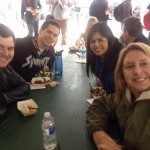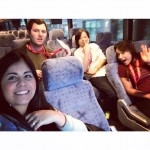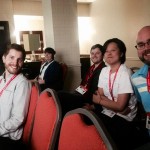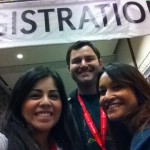From day one I was told no amount of preparation would get me ready for SXSWi. I was determined to prove this wrong; to know every panel, every room, and every distance and time between two panels. I carefully prepared and created a schedule full of balance. I made sure I had panels with speakers ranging from mega media guru’s to panel’s with dense heavy subject matter; futuristic design was accounted for, social media, journalism, big data, wearable technology and technology and art. I had it all.
Yet on the day it felt as if I had done no preparation at all. I hadn’t seen the first panel I wanted to attend was RSVP only. Luckily I was notified by someone on my team most of the panel’s at this particular venue were RSVP only. All my preparation suddenly seemed to shatter around me and I was left trying to put the pieces back together with my bare hands.
My replacement panel I attended was by none other then Hugh Forrest the SXSWi director and curator of events. Jordon Hattery and I had interviewed him earlier this semester on how to be best prepared for SXSWi and his words calmed and reminded me that a flub on the first day wasn’t going to ruin my plans. Following Hugh Forrests talk Gary Vaynerchuk came out to tell us “How to Rock SXSW” even he agreed the name was rather corny.
One of the most inspiring thought provoking moments of this panel came from the Q & A session at set aside at the end of the panel where audience members tweeted in questions. One question that came in sounded like this “How can I meet relevant people here.” Gary became furious. He raised his voiced and said the words “relevant people” are some of the most sickening words he had ever heard. He ranted how if all we look for our people relevant to us and who can help us no one is going to want to talk with us. We would just come off as people who wanted things and not people who actually had anything to give. His core principles seemed to be give away your stuff – give away your ideas and you’ll meet interesting people and be better off then if you try and meet people who are relevant to you. I felt guilty of this as this had been my game plan coming into SXSW. It changed in that moment though, and I decided instead of trying to meet a bunch of people who might be able to get me to the next level of my career I would just enjoy the panels, talk with people, and write as much as I could.
The next five days felt as though I was in an idea store and I only had a limited time to explore the idea’s in the shop. The panels were full of impressive ideas and people. Each day seemed to go smoother and smoother, and even though I sometimes fell away from my plan I rarely ended up somewhere that I didn’t want to be. The presenters at SXSW are the smartest and most interesting people in the tech space at the moment so it was easy to be impressed with even the “bad” panels.
MY BIG TAKEAWAYS
I learned a lot about my gut instinct. I somehow ended up at a lot of journalism and storytelling panels. I don’t think this was by accident, and I hadn’t really planned on attending these panels, yet these were my favorite. These panels reminded me of the importance of paying attention to what you truly enjoy, which is a giant theme underlying many of the panelists stories.
The panels I attended on Journalism were based around data, privacy and security. In an age where we give away our data for new tools it seemed ironic that the one of the big trends that emerged was privacy. Privacy with data, one of the best sentiments I heard echoed at several of these panels was “you may be comfortable with the person currently holding the power, but do you trust the person who will hold the data in several years?” These panels reminded me of the important work that journalists have and the opportunities they have to make an impact.
Another area that drew me in and I noticed as a growing area was the ability to send encrypted information. This was a natural extension of the privacy issue so it appears as concerns rise their will be an increase number of tools we can use to accomplish this. When seeing Glenn Greenwald speak he said when Edward Snowden ended up in Russia they had a difficult time communicating. Glenn had trouble figuring how to set up an encrypted messaging system. This was also mentioned heavily in the Julian Assange, and the Edward Snowden panel. Both were adamant that encrypted communication needs to be made easier to use for the average person.
Watching SXSW attendee’s during a panel there is no way you could make an argument that the second screen revolution is underway. During every panel 60-70% of the attendee’s had their phones, laptops, or out and were tweeting. While not directly a second screen experience it certainly mimics the way we use device while we watch television, or stream or content online. The second screen offers huge opportunities for content creators and developers. Currently second screen experiences exist for niche audiences and only exist for the length of its primary content. The opportunity for a second screen platform to grow as a place for second screen users to share in an experience together exists but has not been taken advantage of yet. With the growth of second screen alongside Netflix second advertisers and developers face the problem of users not all watching content at the same time or during the same time period the opportunity for growth here represents new advertising metrics, new engagement opportunities and new types of second screen experiences that lend itself past the initial time frame of the shows airing.
MY TWO DAYS AS AN EARLY ADOPTER
For this SXSW we had Google Glass. We were a part of the early adopter crew. When I first began this project I had the idea for a marketing campaign to have Google give us a pair of Glass for the conference. After I proposed this idea I tried Google Glass at a marketing expo in downtown Austin. My first reactions of the product left me frustrated and sour that it was not what I imagined. When I found out a pair had been purchased for our project my excitement was minimal. And when we got together to try and practice for our coverage of SXSW I was still unimpressed.
It wasn’t until the end of the first day that I really began to enjoy using it. The more I used it the more I began to see practical applications and ways that it will transform the way people access information, and the advertising opportunities. I began to think of all the potential apps that developers will create with it when it goes public later this year.
Glass changed the way I think about new technologies. At first I couldn’t think of any useful ways to use Glass. As I used it more I began to see more and more potential uses for it. Initial reactions of technologies can be hindering as we are not apt to identify all uses in the first use of something new.
On the first day when the SXTXSTATE team was using Google Glass Jordon had at least half a dozen people come up and ask him about the Glass. During the rest of the day he said it was very common for people to ask him about it. I was the last person to use it on Monday. Only three days later, at this point people had become so accustomed to seeing people with Google Glass that only one person asked me about it before the second day I used was over. People had gotten so used to wearable technology over a weekend that it didn’t phase any one anymore. While not completely surprising at an innovative tech conference it does show how fast we can assimilate to new technology.
FINAL THOUGHTS
SXSW was in some aspects exactly what I thought it would be; interesting ideas, impressive people, new technologies. In other ways it wasn’t at all what I thought it would be. For instance, the most interesting people I met their weren’t interested in networking, or trying to get you to try their app, instead they were just interested in sharing ideas. Just because you had a particular SXSW experience doesn’t mean every one had that same experience with over 800 panels it would be hard to imagine that any two people would go to the same panels over the five days. I think that’s what makes the experience so amazing, yes their are “trends at SXSW” and yes a lot of the same material happens to be covered in different panels, but often times simply by connecting an idea you heard Monday in a panel about wearable technology to a panel on Tuesday about life centered design you arrive at an idea no one has thought of yet.
It was hard work that was easy to have fun doing.
As a final note this was the last class of my graduate experience. It was the final product of two hard, challenging, exciting years in Texas State’s Graduate Mass Communication program and I really can’t think of any better way to finish this experience.





